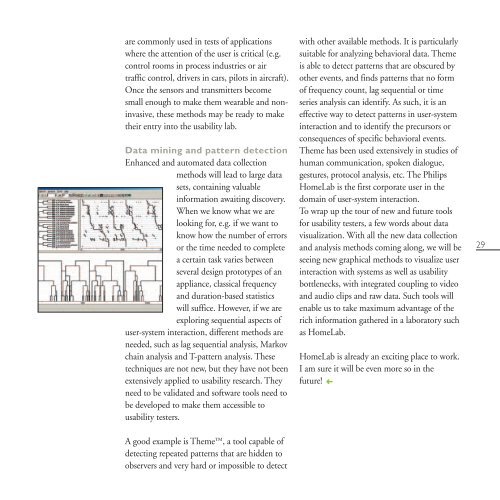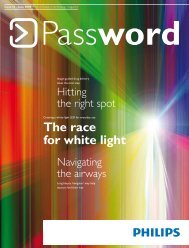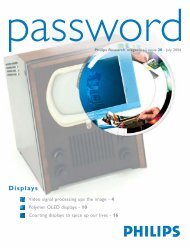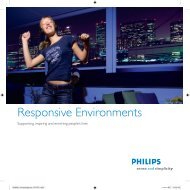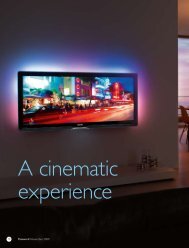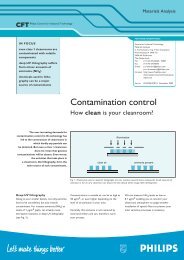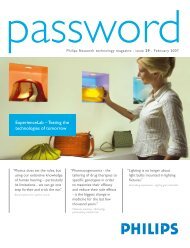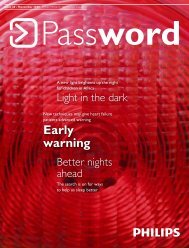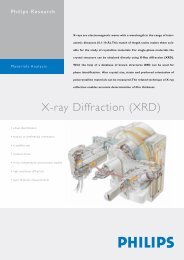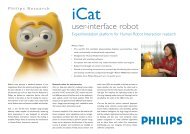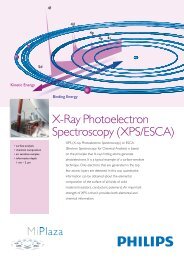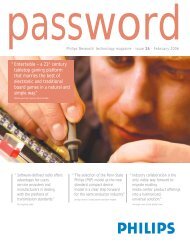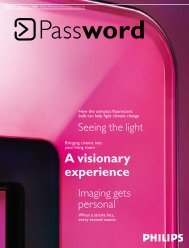365 DAYS AMBIENT INTELLIGENCE IN HOMELAB - Philips Research
365 DAYS AMBIENT INTELLIGENCE IN HOMELAB - Philips Research
365 DAYS AMBIENT INTELLIGENCE IN HOMELAB - Philips Research
Create successful ePaper yourself
Turn your PDF publications into a flip-book with our unique Google optimized e-Paper software.
Ambient 05-05-2003 12:38 Pagina 29<br />
are commonly used in tests of applications<br />
where the attention of the user is critical (e.g.<br />
control rooms in process industries or air<br />
traffic control, drivers in cars, pilots in aircraft).<br />
Once the sensors and transmitters become<br />
small enough to make them wearable and noninvasive,<br />
these methods may be ready to make<br />
their entry into the usability lab.<br />
Data mining and pattern detection<br />
Enhanced and automated data collection<br />
methods will lead to large data<br />
sets, containing valuable<br />
information awaiting discovery.<br />
When we know what we are<br />
looking for, e.g. if we want to<br />
know how the number of errors<br />
or the time needed to complete<br />
a certain task varies between<br />
several design prototypes of an<br />
appliance, classical frequency<br />
and duration-based statistics<br />
will suffice. However, if we are<br />
exploring sequential aspects of<br />
user-system interaction, different methods are<br />
needed, such as lag sequential analysis, Markov<br />
chain analysis and T-pattern analysis. These<br />
techniques are not new, but they have not been<br />
extensively applied to usability research. They<br />
need to be validated and software tools need to<br />
be developed to make them accessible to<br />
usability testers.<br />
A good example is Theme, a tool capable of<br />
detecting repeated patterns that are hidden to<br />
observers and very hard or impossible to detect<br />
with other available methods. It is particularly<br />
suitable for analyzing behavioral data. Theme<br />
is able to detect patterns that are obscured by<br />
other events, and finds patterns that no form<br />
of frequency count, lag sequential or time<br />
series analysis can identify. As such, it is an<br />
effective way to detect patterns in user-system<br />
interaction and to identify the precursors or<br />
consequences of specific behavioral events.<br />
Theme has been used extensively in studies of<br />
human communication, spoken dialogue,<br />
gestures, protocol analysis, etc. The <strong>Philips</strong><br />
HomeLab is the first corporate user in the<br />
domain of user-system interaction.<br />
To wrap up the tour of new and future tools<br />
for usability testers, a few words about data<br />
visualization. With all the new data collection<br />
and analysis methods coming along, we will be<br />
seeing new graphical methods to visualize user<br />
interaction with systems as well as usability<br />
bottlenecks, with integrated coupling to video<br />
and audio clips and raw data. Such tools will<br />
enable us to take maximum advantage of the<br />
rich information gathered in a laboratory such<br />
as HomeLab.<br />
HomeLab is already an exciting place to work.<br />
I am sure it will be even more so in the<br />
future!<br />
➜<br />
29


